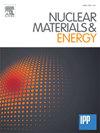Thermomechanical analysis for the theoretical optimization of W/Cu monoblocks with functionally graded interlayer
IF 2.7
2区 物理与天体物理
Q1 NUCLEAR SCIENCE & TECHNOLOGY
引用次数: 0
Abstract
In fusion devices, plasma-facing components (PFCs) play a critical role in withstanding severe thermal conditions resulting from cyclic high heat flux (HHF) loads. The International Thermonuclear Experimental Reactor (ITER) and next-generation fusion devices are expected to employ actively cooled tungsten/copper (W/Cu) monoblocks as divertor targets due to their excellent heat removal capabilities. Although ITER-like monoblocks utilize a soft Cu interlayer to alleviate stress, interface fatigue cracking still occurs under cyclic HHF loads. The issue of interface bonding between the W armor and heat sink has been a limiting factor for the long-term stable operation and structural integrity of these monoblocks. Functionally graded materials (FGMs) are regarded as an effective approach to address severe local stress concentration at the bonding interface. The number of layers, composition distribution, and thickness of the FGM layers are analyzed by evaluating the stress and strain after the loading and cooling phases in finite element simulations. The simulation results indicate that the graded interlayer can significantly reduce stress concentration at the interface, and a two-layer FGM (25 vol% and 66.7 vol% W) with each layer 0.6 mm thick can greatly mitigate both stress and strain. Such results provide important guidance for the development of graded W/Cu monoblocks for fusion applications.
具有功能梯度中间层的W/Cu单块结构理论优化的热力学分析
在核聚变装置中,等离子体面组件(pfc)在承受由循环高热通量(HHF)负载引起的恶劣热环境中起着关键作用。国际热核实验反应堆(ITER)和下一代聚变装置预计将采用主动冷却钨/铜(W/Cu)单体作为导流靶,因为它们具有出色的散热能力。尽管类似iter的单块体利用软Cu夹层来缓解应力,但在循环HHF载荷下,界面仍然会发生疲劳开裂。W装甲和散热器之间的界面连接问题一直是限制这些单体长期稳定运行和结构完整性的因素。功能梯度材料(fgm)被认为是解决键合界面严重局部应力集中的有效方法。通过有限元模拟计算加载和冷却阶段后的应力和应变,分析了FGM层的层数、成分分布和厚度。模拟结果表明,梯度夹层可以显著降低界面处的应力集中,且两层FGM (25 vol%和66.7 vol% W)(每层厚度为0.6 mm)可以显著缓解应力和应变。这些研究结果为开发用于聚变应用的梯度W/Cu单体材料提供了重要的指导。
本文章由计算机程序翻译,如有差异,请以英文原文为准。
求助全文
约1分钟内获得全文
求助全文
来源期刊

Nuclear Materials and Energy
Materials Science-Materials Science (miscellaneous)
CiteScore
3.70
自引率
15.40%
发文量
175
审稿时长
20 weeks
期刊介绍:
The open-access journal Nuclear Materials and Energy is devoted to the growing field of research for material application in the production of nuclear energy. Nuclear Materials and Energy publishes original research articles of up to 6 pages in length.
 求助内容:
求助内容: 应助结果提醒方式:
应助结果提醒方式:


